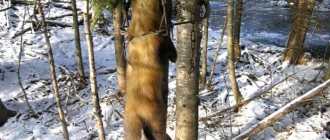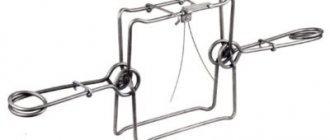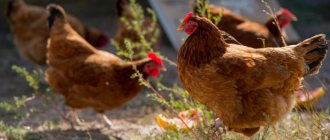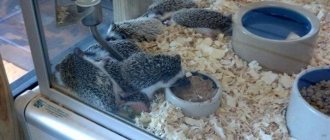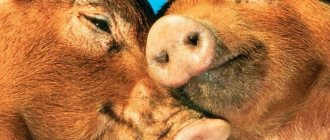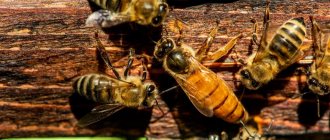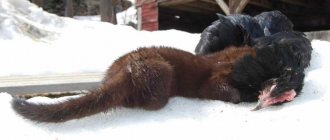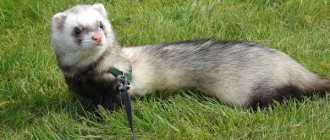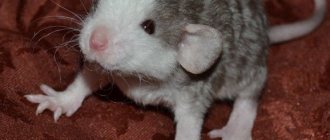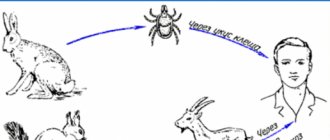In Ancient Rus', hunting for marten, after receiving the highest degree of excitement and pleasure from hunting the animal, also had an important practical nature. Due to the great value of its thick fur, shimmering in the sun, the Russians in ancient times made the animal’s skins a kind of currency - kuna, for the exchange of goods between settlements. The value of such skins was quite high in those days.
In the present, the extraction of this unique, wild and predatory animal from the mustelid family has not lost its relevance either in terms of the thrill of its extraction or in terms of the trophy part.
Marten lifestyle
During the day, the marten rests in a hollow, burrow or nest. She can even adapt someone else's nest for sleep and rest. But with the onset of dusk, the predator becomes active. He climbs trees all night, showing remarkable agility and activity.
At night, the animal eats insects, birds, small mammals, frogs, eggs, berries, nuts on its personal territory, which is located in the taiga or mixed forest. If he finds nothing, he will not disdain carrion. The marten is an excellent mouser and thanks to this it becomes beautiful and well-fed.
The search for food is carried out mainly in forest windbreaks. This makes it difficult for hunters to find the animal and catch it. This predatory mammal of the mustelid family lives from fifteen to twenty-five years. On its small but flexible legs, the marten climbs well, without getting tired at all.
It has sharp claws on all five fingers that help tear apart a rodent or bird. The animal is cute, and not only with its sharp muzzle and beautiful color. On the neck and chest of the marten there is a white spot that distinguishes it from other related animals.
The tail is beautiful and fluffy, especially in winter, and makes up a quarter of the body length. In addition to the common marten, the white marten also lives in Russian forests. It has a snow-white breast color. In addition to this, martens with a yellowish spot on the chest and under the throat live in the northern taiga.
Martens are beautiful at all times of the year. But they look the fluffiest and cutest in winter. Therefore, hunting is carried out precisely in the winter season. The animal is hunted only for its skins; its meat is tasteless and is not eaten.
Fishing methods
If the weasel has already visited the chicken coop once, you need to take drastic measures. To combat the pest, you can use one of the methods suggested below.
Important! Representatives of the mustelid family are repelled by strong smells and loud sounds. This feature must be used to protect poultry from weasels.
Repellers
You can get rid of weasels using different methods. First, you should try special repellers.
- Electronic products. The operating principle of such mechanisms is based on the production of low-frequency sounds that the human ear cannot perceive. They also do not cause harm to health. But the weasels are panicked by these sounds and run away.
- Flashlight with motion sensor. When an animal approaches, such a device reacts to the slightest movement by turning on bright lighting and emitting a sound signal. This scares Laska and she runs away.
Hunting season and trap setting
the marten hunting season to begin from late November to early March. At other times, hunting is not carried out due to the ban. And there’s really no point in hunting down a shedding animal, which is no longer so fluffy and valuable. By winter, martens grow long fur.
Therefore, the marten becomes a valuable trophy for any hunter. You can sew a warm and beautiful fur coat from the skin. The fur of Russian martens is considered the best in the world and therefore the obtained skins can be sold without any problems. Most often, martens are caught using various traps.
To install them, you need to have the necessary knowledge about the marten’s habitat and its habits. A cunning and intelligent animal is not so easy to trap. But hunting with husky and tracking is considered the most exciting and exciting. They often go on such hunts at night.
Only patient hunters hunt marten. After all, you will have to feed the future winter hunting area for many autumn days, regardless of the hunting method. In order not to come home empty-handed, you will need to find the animals’ habitat.
With the onset of winter, snares and traps are placed in a well-fed place near trees with large hollows, at the crossings of forest streams and rivulets. In winter, martens will definitely visit the place that was their free autumn canteen. It’s also worth going fishing with a dog or tracking an animal with a gun.
The marten is a forest dweller, prefers to live in dense thickets
Sweep
Towards the end of winter, this representative of the Kunya family prefers to make shelters in the snow: these can be places under dead wood, under the roots of trees or stumps. At this time, it is common to catch martens with a trap or using a net - a thin but strong net with a cell measuring about three centimeters in size. Along the lower and upper edges of such tackle there are strong rebounds.
Hunters surround the ground shelters of martens with blankets, hanging them on stakes located obliquely and with the top inclined to the outside. In this case, the lower edges of the net are trampled into the snow. The canvas must be hung freely. Therefore, prey caught in such a net ends up as if in a bag.
Hunting marten with husky
Despite the great popularity of catching martens using traps and traps, this fur-bearing animal is also caught in other ways, for example, using a hunting dog. Such active hunting with a four-legged friend brings more vivid sensations than passive testing of traps and loops.
After the chase, the hunter feels a sense of victory when the dead marten ends up in his backpack. Tracking the animal itself can take several hours. This is the time to communicate with the beautiful Russian forest, which has already shed its autumn leaves, but still has not lost its charm.
The hunter and the dog have complete mutual understanding, they have a sense of camaraderie and trust. They follow the trail of the animal with concentration and experience great pleasure from the process. A well-trained husky can track a marten from a great distance from the predator’s place of residence.
She will never get lost in the tracks, no matter how cunning the predator tries to make its existence as secretive as possible. After the marten is discovered, the dog drives it up a tree and barks until its owner appears. The hunter approaches the tree and tries with all his might to drive the marten to the ground.
And there the husky quickly does the owl’s job: it attacks the forest dweller and grabs it by the throat with its teeth, and then brings it to the owner, who must thank his smart and faithful assistant. This type of hunting is only suitable for experienced hunters.
The maximum productivity of this method of preying on a furry predator is only in winter, when the snow cover allows the dog to easily move through the snow. In the middle of winter, meter-long snowdrifts sweep up the forest and they no longer take huskies for hunting.
Dogs are excellent helpers in marten hunting.
Step-by-step manufacturing instructions
a - trap in a charged state, b - trap with the mechanism released; 1 – spring, 2 – pressure, 3 – hook for bait, 4 – guard
- Frame. After cutting the boards into pieces of the required length, we knock down 3 of them in the form of a narrow U-shaped box, open on both sides (without the top and ends for now). In the remaining board for the top we mark holes: a central one, about 3 cm in diameter, two side ones (almost at the front edge of the board, about 1 cm) and 2 very small ones, almost at the level of the central hole (for securing the spring elements - guard, pressure and hook). For the hook, a small longitudinal groove is cut in the board near the guard to prevent the trap from triggering spontaneously.
- A crush is formed from the wire using pliers, the ends of which are inserted into small side holes.
- In the same way, we fold the U-shaped guard and install it upside down (the bar goes under the board) with the rings facing up.
- We insert wire staples into the rings to secure the hook and guard.
- We install the hook and guard on the brackets.
- We fix the finished, equipped top board.
- On the back side we fasten with self-tapping screws a coarse mesh twisted from the same wire.
It is still advisable to paint the wooden parts (this way the frame will not rot in a wet forest, and if you choose a camouflage paint, it will also not be so noticeable). At this point - after the paint has completely dried and the smell has evaporated - the production of the bag can be considered complete.
Photo gallery: Spring bag design
Marten in a spring bag Attaching the bag mechanism Homemade box for the box Bag from the inside Finished bag close-up Finished bag before installation
Video: Making a box with your own hands
Advice: during manufacturing it is necessary to observe safety precautions - since the pressing force of a good spring reaches 10 kg, and if handled carelessly, especially when checking the functionality of the bag, you can break your fingers.
Hunting marten with traps
Traps are different. Some are allowed to catch marten, while others are prohibited. Improper use of traps can lead to accidents or poor hunting results. To catch martens, the use of a frame trap is permitted.
It was made at an industrial enterprise engaged in the production of fishing gear. The frame-type design of traps has a guard, springs, round and square frames. For martens they take a trap numbered zero, one or two. When a predator falls into this factory trap, a mechanism is triggered.
The springs are tensioned between the arms at the installation site and the frame is deployed. The plate trap is also manufactured at the factory. It is prohibited to make and install homemade traps of this type in the forest. The operating principle resembles a frame trap.
But there is a nuance in using special curved metal strips. The fisherman must understand that traps are an inhumane way of catching animals. When an animal is caught with a gun or with the help of a dog, instant or rapid death occurs. And inside the trap the animal cannot move, since its limbs are captured.
He will suffer for a long time until he dies. Death will be long and painful. Therefore, no real hunter uses homemade self-catchers. This is not only inhumane, but also punishable by the laws of the country. Traps can be placed in the forest in a variety of ways.
To successfully harvest a fur-bearing animal, a factory trap must be properly prepared. It is boiled in a pine solution, all factory odors are removed, especially grease. Installation of the trap should be carried out in mittens, which should smell of taiga herbs, and not the smell of a person.
When winter actively comes into its own, the trap may be covered with snow. To prevent this, you should make a canopy over the ditch. A marten trap is often installed on a tree at a height of about two meters. You can place it near a hollow or animal path.
Many methods of hunting marten are prohibited, and experienced hunters generally do not use them
Portable devices
Traps and snares are used to catch martens. The last of these are snares and loops. These portable devices wrap a loop around the marten's body, neck, or limb. It is made from belt, twine or wire.
A noose, a trap and a snare are designed to catch a wide variety of animals - from gophers to bears. Using these self-catching devices, you can also catch various birds - hazel grouse, capercaillie, etc.
Installation of hinges can be done vertically or horizontally. In the first option, the animal will fall into the device with its body or head. In the second case, the marten will step on a noose that will encircle its limb.
To make such a device, you will need soft iron wire with a cross-section from 0.6 to 1.1 mm, the length of which is 1-1.5 m. One end of this piece is twisted into a small ring with a diameter of 5-8 mm. The short end of the wire is wrapped around the long one. The opposite end of the workpiece is threaded into the ring. The clearance of the loop should be about twenty centimeters.
When installing this fishing device, you must ensure that it is located at a distance of ten to fifteen centimeters from the snow cover. A string is tied to the loop through the ring, with which the device is attached to the tree.
Hunting for heaps
Kulemka as a plane was invented by craftsmen from Arkhangelsk. They have been installing this device in the forest for a long time to catch different types of fur-bearing animals. A bag is somewhat reminiscent of a mousetrap, but there is a difference. It is completely covered with boards on the sides and top, so this trap is considered effective and efficient.
The bag is used even in heavy snowfall, and the bait will not be eaten by rodents, voracious birds and other forest inhabitants. Despite the simplicity and simplicity of use, this mechanism allows you to catch a lot of animals without much effort. There is a small waste of time and effort.
Kulemki are now sold in stores for hunters. They are much more humane than traps, since a fur-bearing animal dies instantly and without prolonged torment and agony. With a meager family budget, bags are made at home.
They also work flawlessly and are installed on large tree branches or attached to the trunk. There is always bait for the animal inside the bag, otherwise it will not approach the trap. It is better to use the bag in cold weather.
During thaw days, any animal caught may begin to deteriorate and decompose. In warm weather, it is recommended to check this trap daily. And of course, you shouldn’t be greedy and observe the limit on catching animals, otherwise there will be few martens left in the forest.
Bag for hunting marten and sable
Fishing Features
Traps should not emit a metal smell, this will scare away the animal. It is better to boil them and rub them with the pine needles of some tree.
Often inexperienced hunters make a mistake when leaving traps on the ground. The fact is that martens that fall into a trap run away with it, removing their paws from there. In addition, traps located on the ground cause other forest animals to spoil the skin of the prey caught in them. As a rule, rodents do this.
Catching martens with traps is very common among professional hunters today. And this is not surprising: after all, they can catch two or three “skins” at once, especially if the place is prepared in advance and the prey is fed.
During the cold winter months, you don't need to check your traps too often; just walk around them once a week. Whereas during the thaw, this needs to be done more often so that decomposition does not spoil the skin.
Hunting for loops
Hunting for marten with loops is used only by novice hunters or those hunters who have little conscience. Experienced hunters disdainfully treat marten hunting in this way. Only lazy hunters catch with snares, who place them on the animal’s trail, at the animal’s feeding or daytime resting place.
As a result, the animal gets caught in a loop from which it cannot get out. The noose entangles the animal and strangles its neck, and the marten dies. A professional will never use such a poaching method of catching a forest beauty.
Lures
The marten just never approaches the traps. Hunters definitely have to set bait. As a rule, catching martens with bait traps is the most catchy. Fish or rotten meat, which emits a pungent odor, is used as bait. You can also take carcasses of small rodent animals, for example, squirrels, muskrats or small birds.
The marten bait must be tied in such a way that it hangs down and is not noticed by flying birds. And under the bait, at a distance of up to thirty centimeters, you need to “charge” the trap.
The marten is literally “led” to the smells of essential oils. Therefore, many hunters spray this odorous liquid at a distance of five to six meters from the traps. But you need to be careful and not overdo it, otherwise the prey may be scared off by a too strong smell.
Experienced hunters, for whom catching martens with traps - trapping - has long become a common practice, use anise oil, as well as tincture of valerian or iodoform.
Hunting marten by tracking
But tracking is considered a classic of hunting. This is an interesting, humane and legal fishing method. There are no sneaky loops or homemade traps here. The hunter wanders through the forest with a gun, he does not take the dog with him.
The hunter's intelligence and insight allow him to read marten tracks, untangle them, and lure the animal out of the hollow. An accurate shot with small shot from a gun allows you to kill the animal without spoiling its valuable skin. A properly fired shot will keep your precious fur in excellent condition.
The hunter wanders through the forest, getting great pleasure from it. On the way, you may come across beautiful milk mushrooms or travelers, which you can also put in your backpack. The hunter turns into a real tracker. He sees the bark of trees scratched by marten claws, distinguishes marten droppings from the droppings of other forest animals.
If a marten is found, progressive methods are used to lure the animal out of its shelter. And how much adrenaline increases after a successful shot, when a valuable skin ends up in your backpack.
The method of tracking gives a lot of unforgettable impressions. People go on such hunts in late autumn and early winter, when the snow cover is still small. You can also hunt in the middle of winter, but the results will be worse due to snowdrifts and drifts.
Storage
In summer, fishing devices must be placed in well-ventilated places. You cannot store traps in the garage, as the smells of gasoline and metal will subsequently scare away the animal. The best storage place is the attic. Here the traps are best placed in a box, lined with spruce branches or hay. But even if all the necessary conditions for proper storage have been met, before starting fishing, all equipment must be carefully inspected. The traps are cleaned of any rust present on them, and then boiled in water with the addition of fir or spruce resin. Only in this case will they acquire the smell of the forest and will not scare away the animal. The trap can also be coated with a thin layer of cow butter or lard. This will also rid it of unnecessary odor.
Night fishing for marten
Every hunter knows perfectly well about the night habits of the marten. During the daytime, the marten hides in hollows and goes out hunting at night. Therefore, many fishermen hunt this predator at night. They take with them a hunting dog, a husky, or bypass the mustelids' possession by tracking.
Night hunting for marten gives even more thrills than daytime forays into the taiga. Usually during the day they catch martens only with various traps, such as a bag or a trap. And they engage in active hunting in the dark. At this time the taiga is even more beautiful. Your assistant will be a flashlight, illuminating the path and pointing to the tracks.
When hunting at night, you should be especially well insulated. You definitely can’t do without a warm hat, mittens and felt boots. You need to walk slowly through the forest so as not to run into sharp branches on which you can fall face down. When hunting marten, you should not be greedy.
Take from nature only what you need, leaving the riches of the forest for future generations. Do not use poaching fishing methods. Buy good equipment for a successful hunt. And then the hunting process will give only the most vivid sensations and wonderful trophies.
Use of pets
If a ferret has already gotten into the habit of entering your chicken coop, then, sadly, the animal must be caught.
Pets - cats, dogs - help many farmers by protecting chicken coops from ferrets. They scare away predators, making it difficult to calmly hunt the bird.
The ferret is an active, cautious animal, so it is difficult to catch the enemy of poultry birds, but some pets are valuable hunters. Agile dogs and cats are capable of unexpectedly grabbing and crushing a ferret, weasel, or marten.
Important! Pets that hunt predators must be vaccinated against rabies.
Ferrets and other breeds of domestic ferrets are useful to farmers. They catch rodents by driving wild polecats out of their territory. Well-fed pets do not hunt birds. You should not allow tame ferrets only to the chicks: the chicks will turn out to be a toy for hunting and entertainment.

